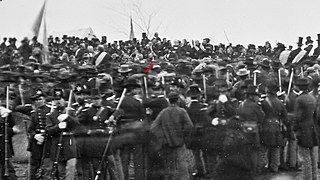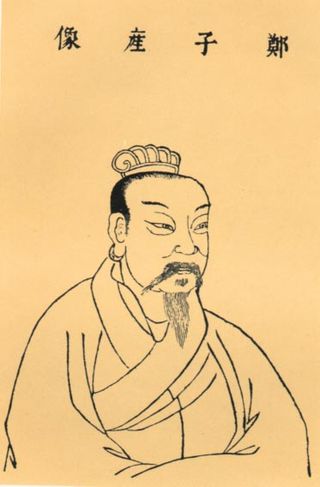Related Research Articles
The Chinese classics or canonical texts are the works of Chinese literature authored prior to the establishment of the imperial Qin dynasty in 221 BC. Prominent examples include the Four Books and Five Classics in the Neo-Confucian tradition, themselves an abridgment of the Thirteen Classics. The Chinese classics used a form of written Chinese consciously imitated by later authors, now known as Classical Chinese. A common Chinese word for "classic" literally means 'warp thread', in reference to the techniques by which works of this period were bound into volumes.

Persuasion or persuasion arts is an umbrella term for influence. Persuasion can influence a person's beliefs, attitudes, intentions, motivations, or behaviours.

Public speaking, also called oratory, is the practice of delivering speeches to a live audience. Throughout history, public speaking has held significant cultural, religious, and political importance, emphasizing the necessity of effective rhetorical skills. It allows individuals to connect with a group of people to discuss any topic. The goal as a public speaker may be to educate, teach, or influence your audience. Individuals can utilize visual aids like a slideshow, pictures, and short videos to get their point across. Whether a student, teacher, preacher, or business owner;public speaking can be relevant for those careers. Utilizing public speaking skills is essential because it builds confidence and transforms how individuals share your ideas with others.

Rhetoric is the art of persuasion. It is one of the three ancient arts of discourse (trivium) along with grammar and logic/dialectic. As an academic discipline within the humanities, rhetoric aims to study the techniques that speakers or writers use to inform, persuade, and motivate their audiences. Rhetoric also provides heuristics for understanding, discovering, and developing arguments for particular situations.
Shen Dao was an early to mid Warring states period Chinese philosopher and writer. Noteworthy as a predecessor to both Han Fei and Daoism, his remaining fragments are the most substantial of any Jixia Academy scholar, and may have been well known. Early remembered modernly for his influence on the Han Feizi with regards the concept of shi, most of his work would appear to have concerned the concept of fa commonly shared by others that the Han Confucian archivists classified as Legalist.
Han Fei, also known as Han Feizi, was a Chinese Legalist philosopher and statesman during the Warring States period. He was a prince of the state of Han.

The Han Feizi is an ancient Chinese text attributed to the Legalist political philosopher Han Fei. It comprises a selection of essays in the Legalist tradition, elucidating theories of state power, and synthesizing the methodologies of his predecessors. Its 55 chapters, most of which date to the Warring States period mid-3rd century BCE, are the only such text to survive fully intact. The Han Feizi is believed to contain the first commentaries on the Dao De Jing. Traditionally associated with the Qin dynasty, succeeding emperors and reformers were still influenced by Shen Buhai and the Han Feizi, with Shang Yang's current again coming to prominence in the time of Emperor Wu.

Ethos is a Greek word meaning 'character' that is used to describe the guiding beliefs or ideals that characterize a community, nation, or ideology; and the balance between caution and passion. The Greeks also used this word to refer to the power of music to influence emotions, behaviors, and even morals. Early Greek stories of Orpheus exhibit this idea in a compelling way. The word's use in rhetoric is closely based on the Greek terminology used by Aristotle in his concept of the three artistic proofs or modes of persuasion alongside pathos and logos. It gives credit to the speaker, or the speaker is taking credit.
Pathos appeals to the emotions and ideals of the audience and elicits feelings that already reside in them. Pathos is a term most often used in rhetoric, as well as in literature, film and other narrative art.

Inventio, one of the five canons of rhetoric, is the method used for the discovery of arguments in Western rhetoric and comes from the Latin word, meaning "invention" or "discovery". Inventio is the central, indispensable canon of rhetoric, and traditionally means a systematic search for arguments.

Aristotle's Rhetoric is an ancient Greek treatise on the art of persuasion, dating from the 4th century BCE. The English title varies: typically it is Rhetoric, the Art of Rhetoric, On Rhetoric, or a Treatise on Rhetoric.

Zichan was a Chinese statesman during the late Spring and Autumn period. From 543 until his death in 522 BCE, he served as the chief minister of the State of Zheng. Also known as Gongsun Qiao (traditional Chinese: 公孫僑; simplified Chinese: 公孙侨, he is better known by his courtesy name Zichan.

The modes of persuasion, modes of appeal or rhetorical appeals are strategies of rhetoric that classify a speaker's or writer's appeal to their audience. These include ethos, pathos, and logos, all three of which appear in Aristotle's Rhetoric. Together with those three modes of persuasion, there is also a fourth term, kairos, which is related to the “moment” that the speech is going to be held. This can greatly affect the speaker’s emotions, severely impacting his delivery. Another aspect defended by Aristotle is that a speaker must have wisdom, virtue, and goodwill so he can better persuade his audience, also known as Ethos, Pathos, and Logos.

Rhetoric of science is a body of scholarly literature exploring the notion that the practice of science is a rhetorical activity. It emerged after a number of similarly oriented topics of research and discussion during the late 20th century, including the sociology of scientific knowledge, history of science, and philosophy of science, but it is practiced most typically by rhetoricians in academic departments of English, speech, and communication.
The Guanzi is an anonymously written, foundational Chinese political and philosophical text originally comprising 86 chapters, of which 76 survive. Compiled in the early Han dynasty, earlier versions potentially date back to the late Warring states period. At over 135,000 characters, it is one of the longest early Chinese philosophical texts. It covers broad subject matter, notably including price regulation of commodities via the concept of "light and heavy" (轻重). Despite its later dating, it is arguably one of the most representative texts of the concepts of political economy that developed during the Spring and Autumn period. Ming dynasty agricultural scientist Xu Guangqi still frequently cited the Guanzi and the Xunzi.
Fangshi were Chinese technical specialists who flourished from the third century BCE to the fifth century CE. English translations of fangshi include alchemist, astrologer, diviner, exorcist, geomancer, doctor, magician, monk, mystic, necromancer, occultist, omenologist, physician, physiognomist, technician, technologist, thaumaturge, and wizard.
Huang–Lao was the most influential Chinese school of thought in the early Han dynasty, having its origins in a broader political-philosophical drive looking for solutions to strengthen the feudal order as depicted in Zhou politics. Not systematically explained by historiographer Sima Qian, it is generally interpreted as a school of Syncretism, developing into a major religion, the beginnings of religious Taoism.
The Shizi is an eclectic Chinese classic written by Shi Jiao 尸佼, and the earliest text from Chinese philosophical school of Zajia, which combined ideas from the Hundred Schools of Thought, including Confucianism, Daoism, Mohism, and Legalism. The Shizi text was written c. 330 BCE in twenty sections, and was well known from the Han dynasty until the Song dynasty (960–1279) when all copies were lost.

Feminist rhetoric emphasizes the narratives of all demographics, including women and other marginalized groups, into the consideration or practice of rhetoric. Feminist rhetoric does not focus exclusively on the rhetoric of women or feminists but instead prioritizes the feminist principles of inclusivity, community, and equality over the classic, patriarchal model of persuasion that ultimately separates people from their own experience. Seen as the act of producing or the study of feminist discourses, feminist rhetoric emphasizes and supports the lived experiences and histories of all human beings in all manner of experiences. It also redefines traditional delivery sites to include non-traditional locations such as demonstrations, letter writing, and digital processes, and alternative practices such as rhetorical listening and productive silence. In her book, Rhetorical Feminism and This Thing Called Hope (2018), Cheryl Glenn describes rhetorical feminism as, "a set of tactics that multiplies rhetorical opportunities in terms of who counts as a rhetor, who can inhabit an audience, and what those audiences can do." Rhetorical feminism is a strategy that counters traditional forms of rhetoric, favoring dialogue over monologue and seeking to redefine the way audiences view rhetorical appeals.
References
- ↑ Yameng, Liu (1996). "To capture the essence of Chinese rhetoric: An anatomy of a paradigm in comparative rhetoric". Rhetoric Review. 14 (2): 318–335.
- ↑ Liu, Donghong (2019-08-06). "Comparative rhetoric and emic approaches to Chinese persuasive strategies in hotel discourse". Journal of Asian Pacific Communication. 29 (2): 168–187. doi:10.1075/japc.00029.liu. ISSN 0957-6851.
- ↑ Garrett, Mary M (1993). "Pathos reconsidered from the perspective of classical Chinese rhetorical theories". Quarterly Journal of Speech. 79 (1): 19–39. doi:10.1080/00335639309384017.
- ↑ Ziyu, Zheng (1984). Zhongguo Xiucixue Shi Gao [A Draft History of Chinese Rhetoric]. Shanghai: Shanghai Jiaoyu Chubanshe [Shanghai Education P].
- 1 2 Cai, Guanjun (1998). A Chinese rhetorical tradition? Case studies in the history of Chinese rhetorical theory and practice [doctoral thesis]. Tucson, AZ: University of Arizona.
This article has not been added to any content categories . Please help out by adding categories to it so that it can be listed with similar articles. (January 2025) |